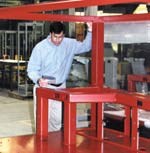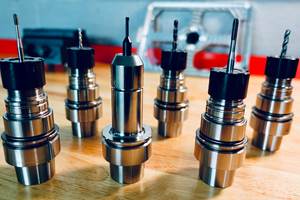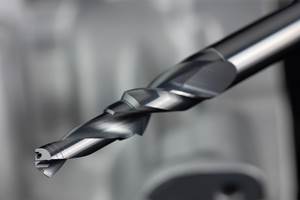Reclaiming The Hole-making Process
A shop that had been farming out hole-making operations on oversized components brought this work back in-house after acquiring a large-format, CNC drilling machine. The process now can be done more quickly, at lower costs and on schedule, with many workpieces machined as assemblies instead of separate pieces
Southbridge Sheet Metal Works, Inc., a metal fabricating shop in Sturbridge, Massachusetts, builds frames made of plate and structural tubing for New England equipment manufacturers. The family-owned shop started in the town for which it is named back in 1934, and president Louis E. (Lou) Colognesi, Jr., can point to many changes that have occurred in the industry over the years.
“Twenty-five years ago, we did a lot of work for builders of machine tools and textile machines,” Mr. Colognesi recalls. “Those firms were vertically integrated; they would buy fabricated assemblies from us and do most of the machining and finishing in-house. Many of those companies are gone now. Today, we supply frames and chassis to manufacturers of laser machines, medical equipment, x-ray inspection equipment and similar high-tech products. Our new customers tend to be less vertically integrated; they want components and assemblies that are as complete as possible and ready to go right on the assembly line. To serve our customers’ needs and stay competitive, we could no longer simply supply welded assemblies. We had to be able to provide machining and painting of components and assemblies as well.”
Over time, Southbridge Sheet Metal added an assortment of hole-making machines that includes drill presses, radial drills . . . even two CNC machining centers. The machines are fine for drilling and tapping many of the smaller components that go into its assemblies (small pieces of steel plate, square tube and rectangular tube), but they simply cannot accommodate large sections of plate that are used as bases for many of the machine frames. The shop tried to drill and tap the large sections of plate on its radial drills, which were the largest hole-making machines in the shop, but the process was too slow, and repositioning the machine and the workpiece to get at all the hole locations was too time consuming and cumbersome.
To provide the needed drilled and tapped holes, Southbridge farmed out the work to machine shops in the area. One shop machined the large plate sections on a boring mill. Another shop used a large bridge mill. Farming out the work achieved the desired results, but there were drawbacks: “In the first place, having the machining done by a third party is expensive. The machines that were used were large and had high hourly rates to begin with, and the shops naturally tacked on a profit margin that we had to pass through to our customer,” Mr. Colognesi explains.
“Having work done on the outside can also affect delivery times,” he continues. “The time it takes to get a job done on the outside depends on how busy the shops are. Right now, we can have jobs done quickly. Last summer, shops were quoting 10- to 12-week waits. Another consideration: if your source’s machine breaks down, you’re dead in the water.”
The need to machine large plate sections has been a longstanding concern at Southbridge Sheet Metal. For example, the shop has been supplying fabricated machine frames to one customer at a rate of one to five per week for the last 5 years. The frame has a base made from a ½-inch-thick steel plate that measures approximately 6 feet by 10 feet and has 170 holes of various sizes, most of them tapped. The shop outsourced the machining of the base to a machine shop that performed the hole-making operations on a boring mill.
Too Much Machine
Southbridge Sheet Metal wanted to bring the machining in-house to gain more control of costs and scheduling. There were many machines on the market capable of machining large plate sections, but Mr. Colognesi felt they were more machine than he needed for the relatively simple drilling and tapping operations his workpieces required.
The search for a more appropriate machine continued, and while visiting a regional machine tool trade show (EASTEC), Mr. Colognesi found what he was looking for—the VersaDRILL large-format drilling machine made by Vytek Inc. (Littleton, Massachusetts). VersaDRILL is a CNC, gantry-style drilling machine designed for efficient drilling, tapping and light milling of large plate sections. The machine is available in two versions: a smaller-capacity LT series and an HD (heavy duty) series. Southbridge Sheet Metal purchased the heavy duty version.
The HD is available in table sizes ranging from 75 inches by 75 inches to 125 inches by 125 inches, and in weight capacities up to 20,000 pounds. It has an optional automatic tool change capability, enabling the machine to access as many as 20 tools mounted in stationary tool stations at one end of the worktable. (See Figure 1.) The machine provides 16 inches of clearance beneath the gantry, enabling relatively flat, welded subassemblies (and whole assemblies) to be machined as a unit. The machine has a freestanding CNC control with a PC interface. The control is equipped with a Windows-based CAM software.
By purchasing the drilling machine, Mr. Colognesi was able to bring the machining of the bases for his long-running frame job in-house. He found that he is able to machine the base on the VersaDRILL in half the time that it had been taking the machine shop to do the job on its mill. He estimates that if he had purchased the unit 5 years ago, the savings gained by machining the bases in-house for just the one job would have repaid the cost of the machine.
“The flexibility that the machine provides is important too,” he adds. “The ability to machine plates on demand for the welding department, the avoidance of having to move the plate back and forth, the reduced handling, and the more reliable scheduling . . . are a few more benefits we’ve gained with our new machine.”
Doing Things Differently
The new machine has actually changed the way that assemblies come together at Southbridge Sheet Metal. Before, components of an assembly were machined separately and then secured in welding jigs that kept the holes aligned for welding. Now, the vertical clearance on the new machine is such that, in many cases, a welded subassembly or complete assembly can be mounted on the machine and machined as a unit.
“We’re saving time because we’re doing all of the machining at one time in one place,” Mr. Colognesi affirms. “The welder no longer has to worry about aligning hole patterns on separately drilled components. We’ve eliminated all of the drill jigs that we were using on our radial drills and many of our welding fixtures as well.”
Another example of the flexibility of the VersaDRILL is the 3/8-inch-thick, 18-inch-by-48-inch, steel base plate for a CAT scan machine shown being machined in Figure 2. The base plate requires some 60 drilled and tapped holes of different sizes. In addition, a bevel is milled along the entire periphery of the part.
A blank is mounted at each end of the worktable, and while the machine is busy machining a blank at one end, the operator removes a finished part and loads a fresh blank at the other end. The time from the finish of machining on one base to the start of machining on the next can be as short as the time it takes the gantry to move to the other end of the table. Previously, the bases were farmed out to a machine shop that performed the machining on a large vertical machining center.
“The bottom line is that we’re keeping more work in-house, where we can do it economically and accurately,” Mr. Colognesi notes. “We can also turn jobs around faster.” He reports that the new machine is saving 1 to 2 weeks on most jobs, but it has the potential for greater time savings as the shop explores ways to exploit its capability.
Related Content
How Lowering Torque Improves Tapping Tool Life
Escaping the tap breakage trap requires a long look at torque and the many factors that influence it.
Read MoreCustom PCD Tools Extend Shop’s Tool Life Upward of Ten Times
Adopting PCD tooling has extended FT Precision’s tool life from days to months — and the test drill is still going strong.
Read MoreNew Modular Tool Options for Small Spindle Milling
Tooling options have been limited for small spindle milling applications. Now modular, indexable systems are available that provide broad flexibility to get the right cutter for the job with less inventory and at lower cost.
Read MoreEmuge-Franken's New Drill Geometry Optimizes Chipbreaking
PunchDrill features patent-pending geometry with a chipbreaker that produces short chips to control machining forces.
Read MoreRead Next
The Cut Scene: The Finer Details of Large-Format Machining
Small details and features can have an outsized impact on large parts, such as Barbco’s collapsible utility drill head.
Read More3 Mistakes That Cause CNC Programs to Fail
Despite enhancements to manufacturing technology, there are still issues today that can cause programs to fail. These failures can cause lost time, scrapped parts, damaged machines and even injured operators.
Read More











.png;maxWidth=300;quality=90)






















